We Offer Telemedicine Appointments.
Herniated Disc
The Difference Between Bulging Disc and Herniated Disc
The Difference Between Bulging Disc and Herniated Disc
Before we dive into the details of a bulging disc and herniated disc is important to understand the basics of the spine and disc anatomy.
Spine Anatomy: Your spine serves the essential functions of providing your body support and structure, allowing you to stand, bend, and twist. The spine also protects your spinal cord (part of your central nervous system) which is a highway of nerve signals allowing you to move and feel sensations. The spine is comprised of 33 bones which are divided into three major sections:
- Cervical: seven vertebrae that form the neck
- Thoracic: twelve vertebrae that form the upper and mid-back
- Lumbar: five vertebrae that form the lower back
Each vertebra is separated by a fibrous intervertebral disc (IVD) which is made up two parts:
- Nucleus pulposus: This is the jelly-like inner core of the disc. It is made up of roughly 80% water as well as collagen fibers. Its elasticity allows each disc to act as a shock absorber for the spine.
- Annulus fibrosus: The annulus is made up of seven to 15 layers of fibers surrounding and protecting the nucleus. Each has a slight arch or curvature of about 30° that provides traction and structural support for the disc.
When your spine moves the discs in your adjust slightly to support the vertebrae. For example, when you bend over the anterior (front of your disc) compresses and the posterior (back of the disc) stretches.
Regions of the Spine

Normal Disc
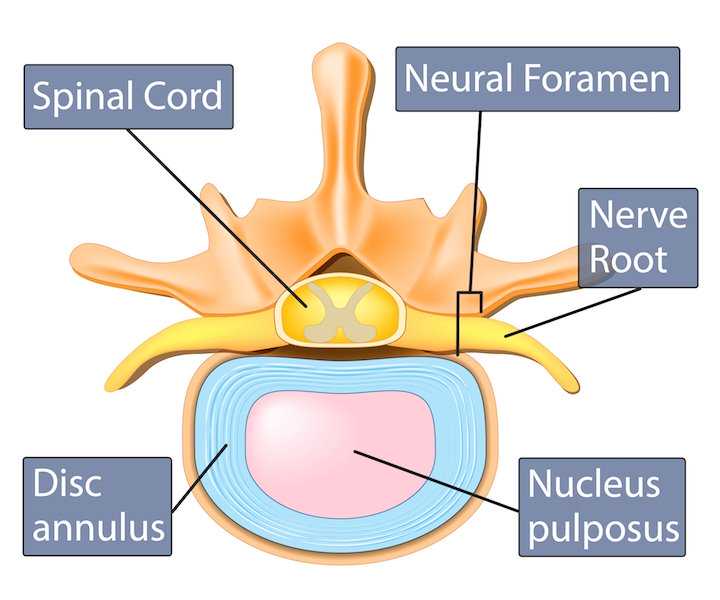
Bulging Disc vs Herniated Disc
Bulging Disc
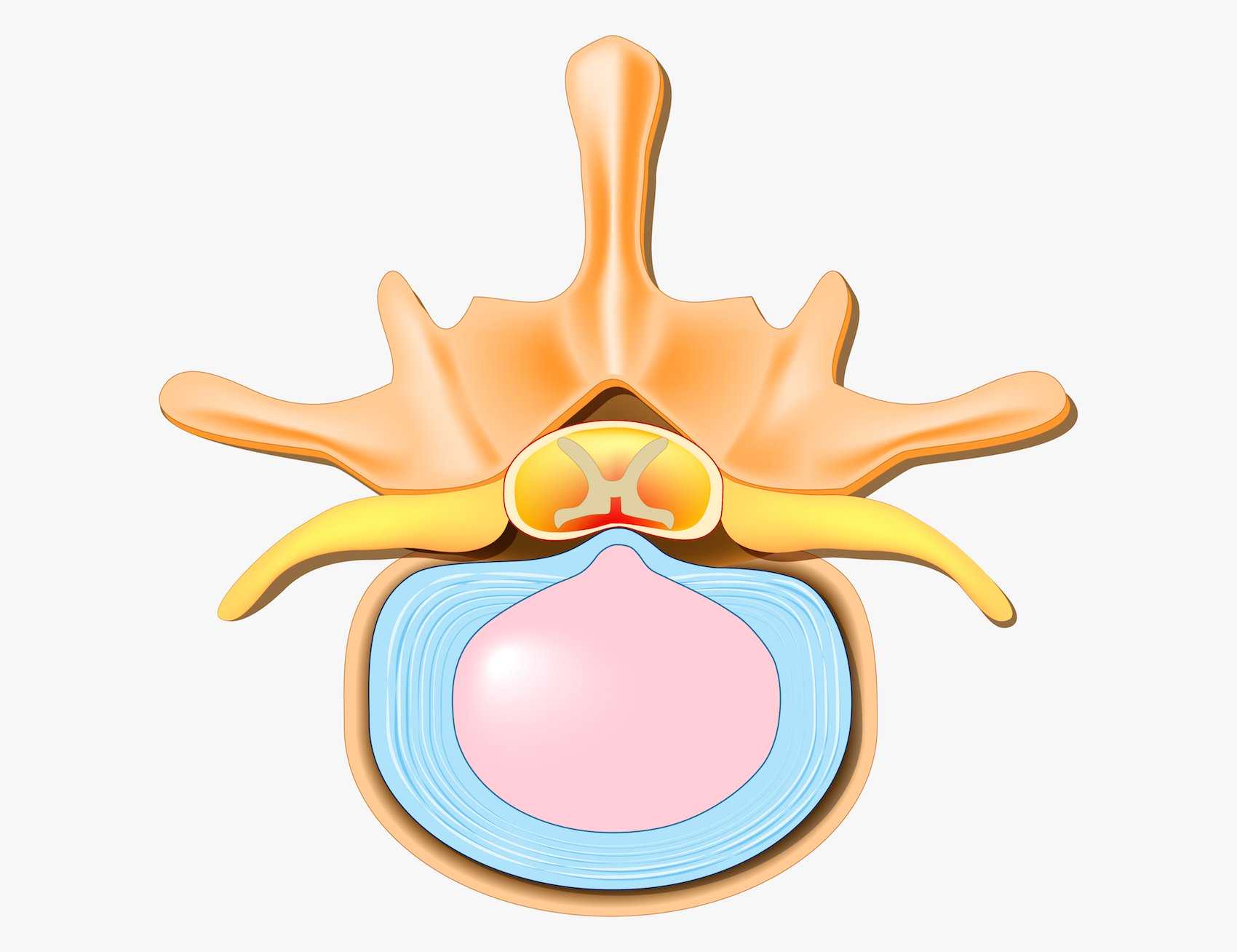
What is a bulging disc?
Unlike a herniated disc, when the nucleus breaks through the annulus, a bulging disc protrudes outward but the outer layers of the annulus remains intact. However, because the disc protrudes into the spinal canal, it can still compress a nerve root. Disc bulge is also called disc prolapse.
Herniated Disc
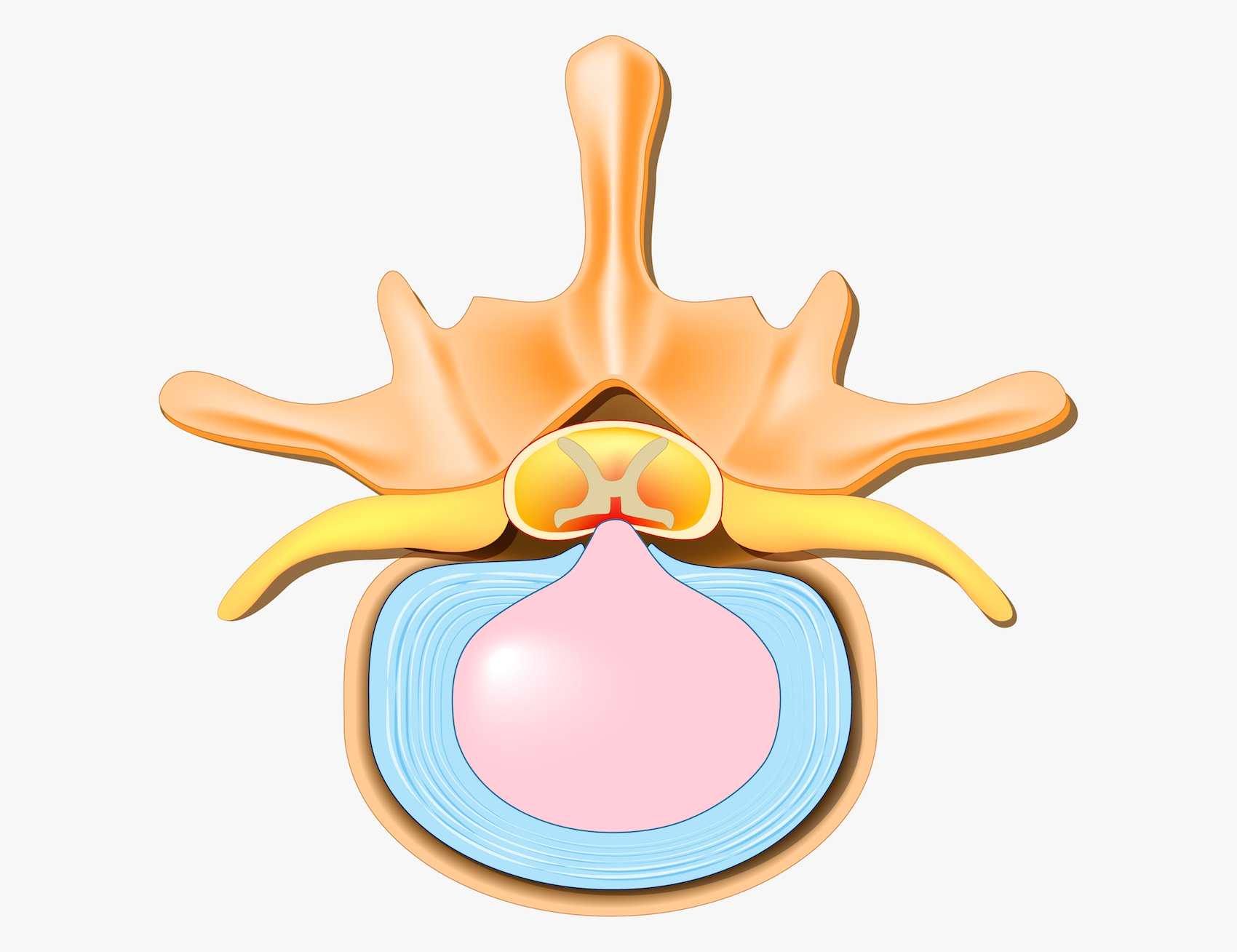
What is a herniated disc?
When a disc herniates, the soft nucleus spurts out through a tear in the annulus. Because there is limited space in the spinal canal, the nucleus can compress a nerve root or the spinal cord. The nucleus can extrude into the spinal canal, foramen, on either side of the disc, or in some rare cases, in multiple places called multifocal extruded discs. Typically, a disc that herniates is in the final stages of degeneration. Although herniated discs can occur in any area of the spine, they are more common in the lumbar region.
Other terms used describe herniated discs include disc extrusion, slipped disc, or ruptured disc.
Free Fragments
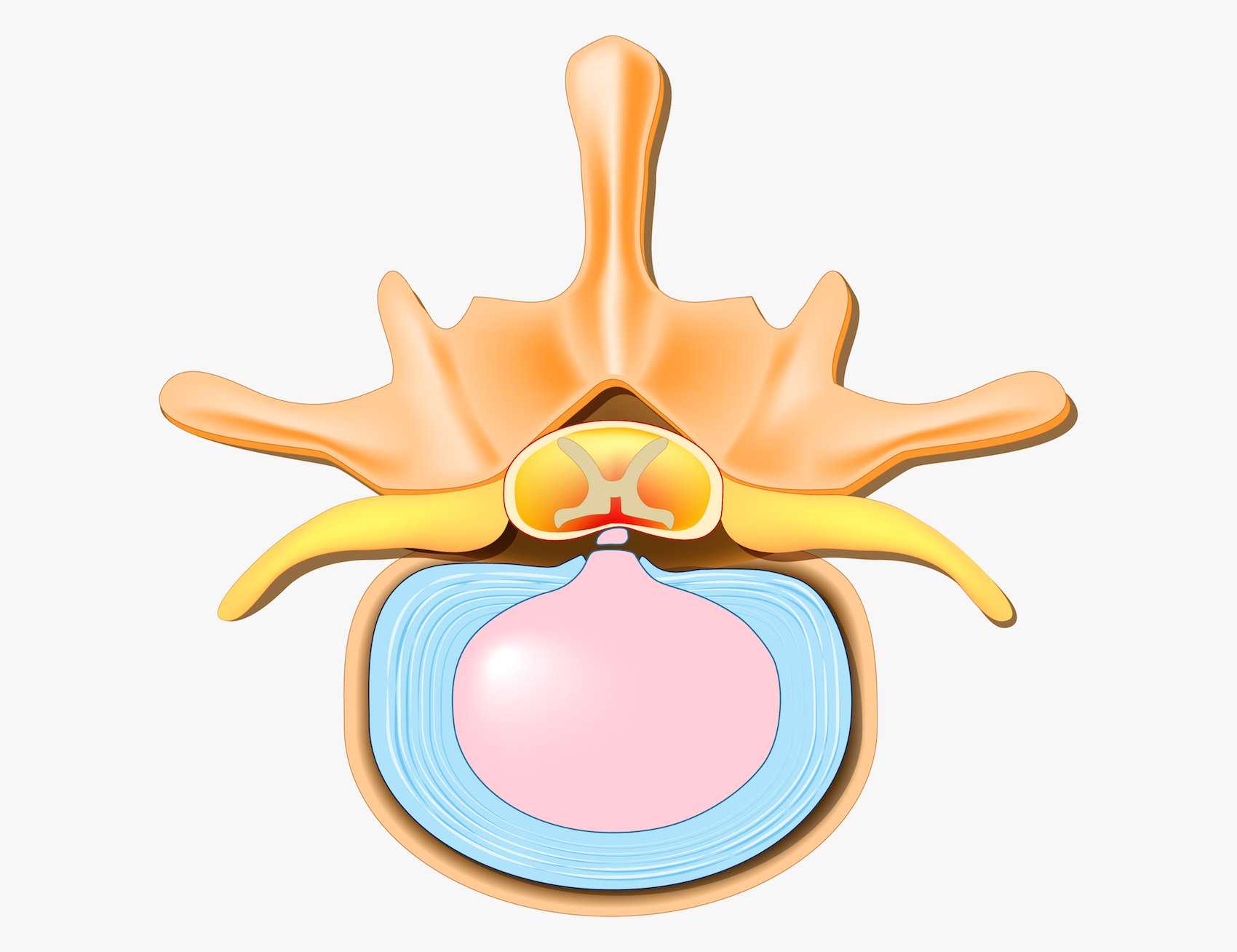
Free Fragments
In some cases a piece or pieces of the herniated disc might break off, these are called free fragments. A free fragment, also known as a sequestered disc, can break off in the spinal canal and apply pressure on the spinal cord which can result in severe pain and injury.
Types of Herniated and Bulging Discs
Herniated and Bulging discs can occur in the Cervical, Thoracic, or Lumbar regions of the spine.
- Cervical disc herniation: This is when a disc herniates in the neck. It is one of the most common causes of neck pain.
- Thoracic disc herniation: This is when a disc herniates in the upper or mid-back.
- Lumbar disc herniation: This is when a disc herniates in the lower back. It is a common cause of lower back pain.
Herniated and Bulging discs can also be classified by the area of the disc they protrude into (herniation zone).
- Central: When the disc extrudes into in the spinal cord.
- Subarticular (Lateral Recess or Paracentral): When the disc extrudes between the spinal cord and the foramen (the space through which the nerves exit the spinal canal).
- Foraminal (Lateral): Disc extrusion into the foramen.
- Extraforaminal (Far Lateral): Disc extrusion beyond the foramen.
Herniation Zones
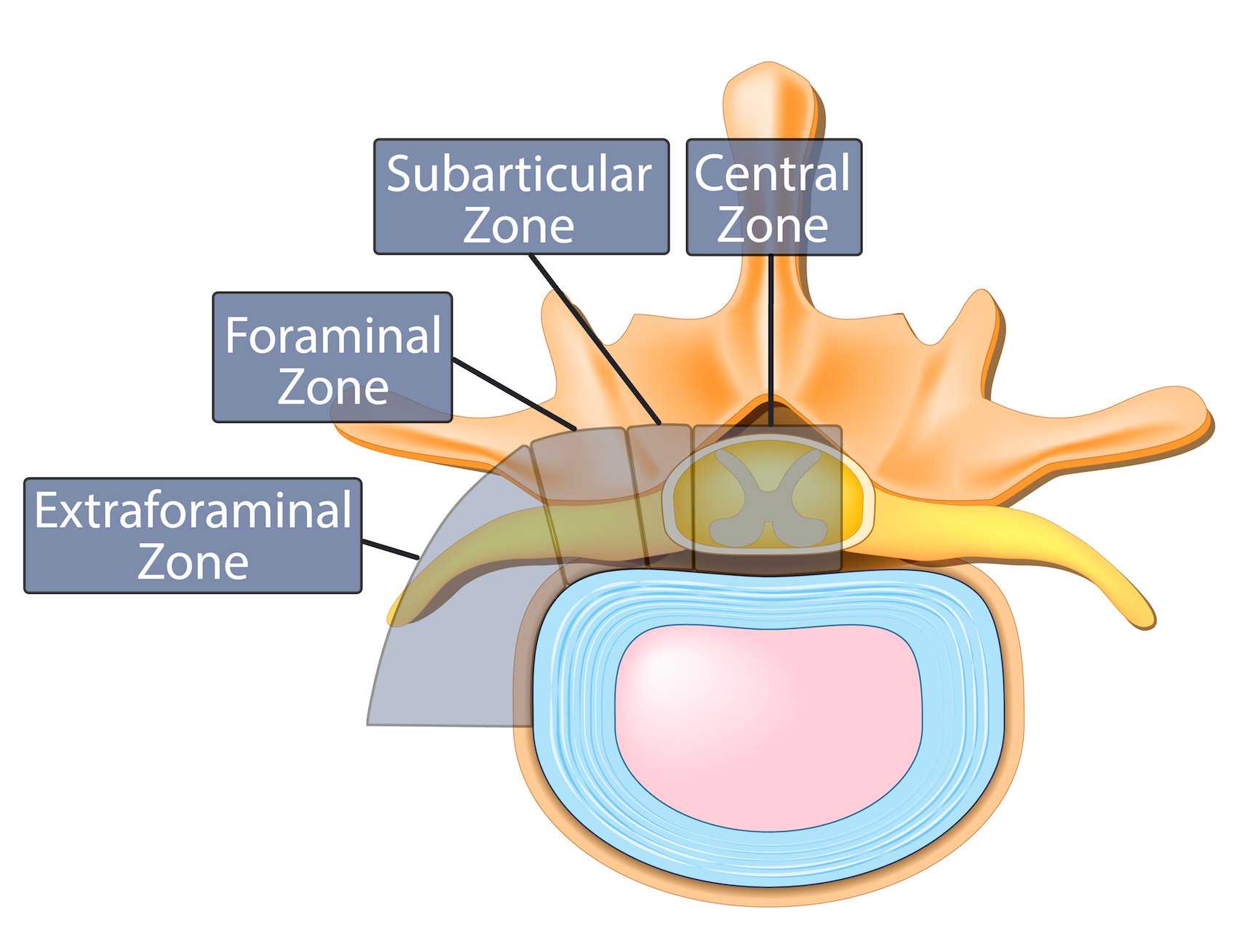
Bulging Discs Classification
Asymmetric Disc Bulge
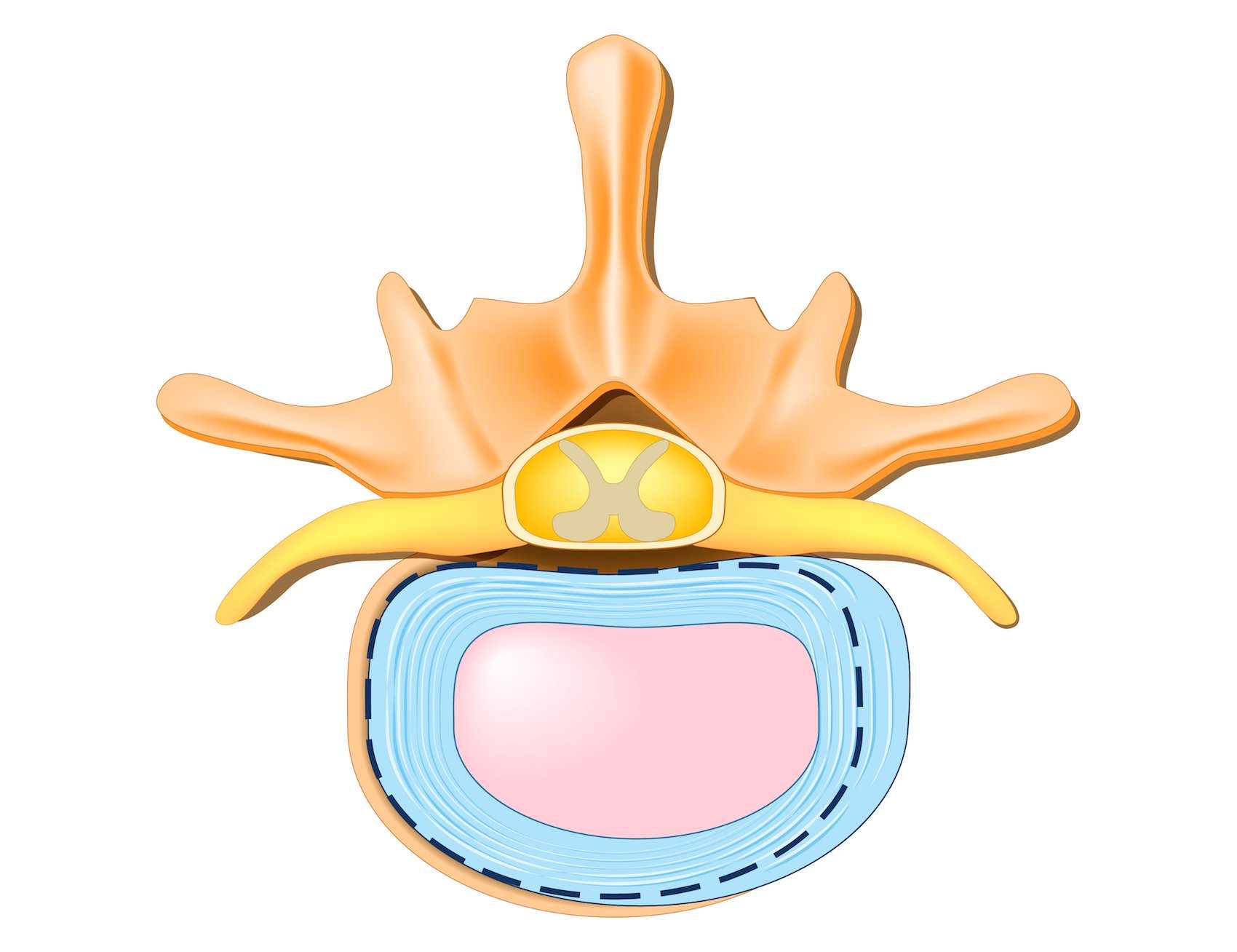
Asymmetric disc bulge (Broad-based disc bulge): The bulge involves 25 to 50% of the disc’s circumference.
Circumferential Disc Bulge
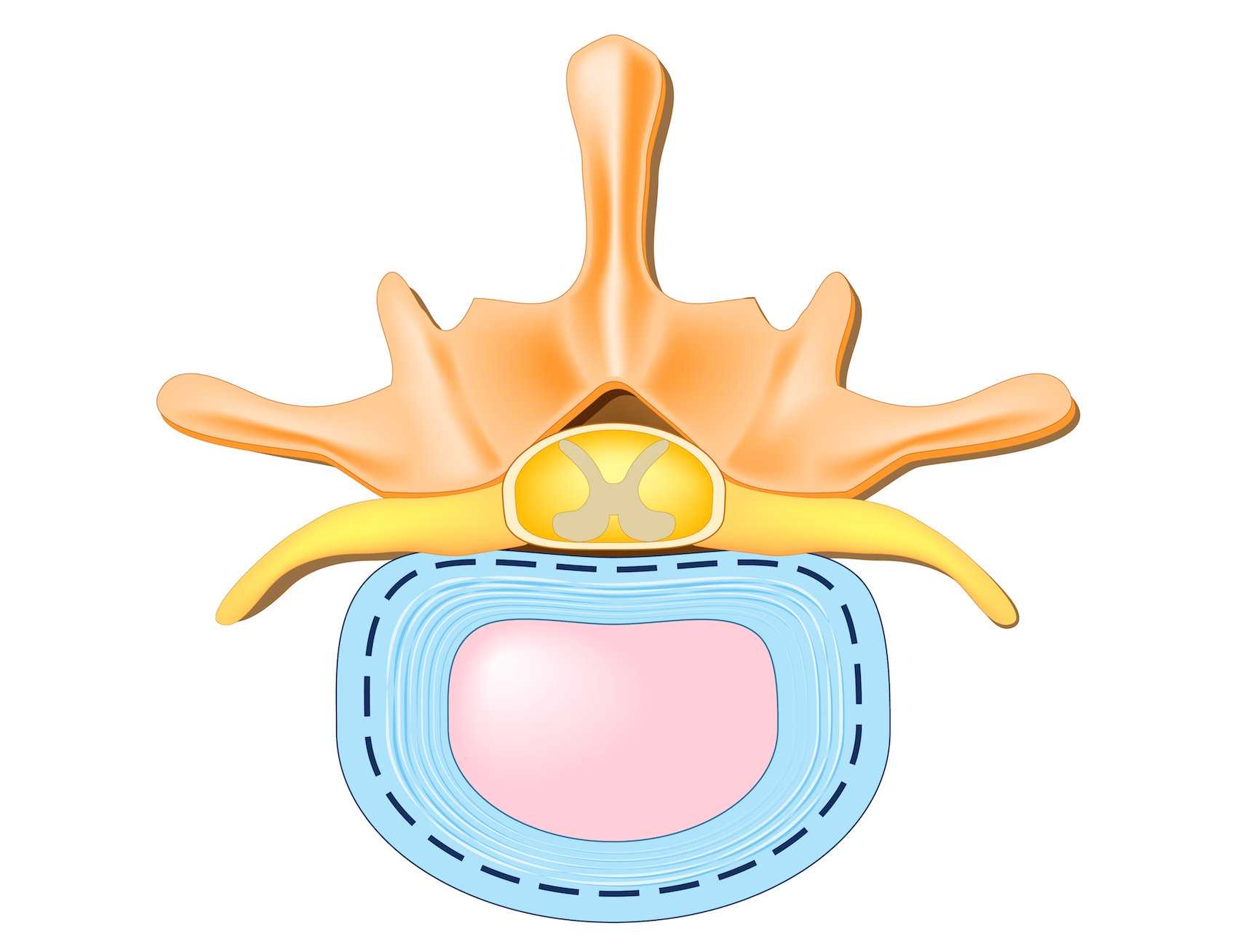
Circumferential disc bulge (Diffuse disc bulge): The bulge extends beyond the entire disc circumference.
Herniated Disc Symptoms
Overall, symptoms of a herniated disc include: pain throughout an arm or leg, burning or tingling sensations in the affected area, muscle weakness, pain that worsens after pronlonged sitting or standing, pain or numbness that radiates down one side of the body, pain that becomes more severe during the night or Imparied ankle or knee reflexes. Herniated disc pain may be mild to severe.
Symptoms by Region of the Spine
Herniated Cervical Disc(neck): Pain shooting down the arm to the fingertips, numbness, tingling, or weakness in the shoulder, arm or hand, difficulty walking or maintaining balance or problems gripping or handling things.
Herniated Thoracic Disc (upper and mid-back): Pain from the lower neck to the mid-back, chest pain, headaches when lying down, difficulty walking, tingling, numbness, or burning sensation in the legs, weakness in the legs or problems with the bladder or bowels.
Herniated Lumbar Disc (lower back): Pain in your lower back, buttocks, hamstring, calf, or feet, numbness or tingling in the affected leg, shooting pain down you leg, weakened leg muscles, burning or sharp pain in your leg that worsens when standing long periods of time, difficulty controlling the bladder or bowels, difficulty walking, abnormal ankle and knee reflexes, poor coordination, difficulty lifting the feet or cramping in the lower back or legs.
Causes of a Herniated Disc
The most common cause of disc herniation is age-related wear and tear. This is known as disc degeneration. As your body ages, the amount of water in your vertebral discs decreases, making them less flexible and more prone to tearing. Certain motions, such as twisting, turning, or lifting can also cause a herniated disc. Although less common, an injury such as a car accident or a blow to the back can cause a herniated disc.
Causes of a Bulging Disc
Like a herniated disc, the most common cause of a bulging disc is degenerative disc disease. A bulging disc may also be caused by neck or back strain brought on by repetitive movements, lifting heavy objects, and poor posture. This condition can also be caused by trauma such as a blow to the back, although this is rare.
- Wear and tear caused by degenerative disc disease
- Strain due to heavy lifting and repetitive movements
- Poor posture while standing or sitting
- A hereditary condition
Herniated and Bulging Disc Risk Factors
Risk factors for these conditions include:
- Men aged between 30 and 50 years are more likely than women to suffer a herniated disc.
- People who have physically demanding jobs, such as those which involves repetitive motion or heavy lifting.
- Men and women who are obese or overweight are at risk because of the excess weight on their spine. They are also more likely to have the same disc herniate again.
- Smoking tobacco increases the risk of a herniated disc because nicotine reduces the flow of blood to the vertebral discs. Not only does this increase disc degeneration, but it also slows down the healing process.
- Your risk of a herniated or bulging disc is increased if one or both of your parents suffer from these conditions.
At the Miami Neouroscience Center we help patients with Herniated and Bulging Discs using the latest techiques and treatments, contact us today.
FAQ - Herniated and Bulging Disc Frequently Asked Questions
It can be difficult to recognize a herniated disc from other causes of back pain. Herniated discs most commonly occur in the lumbar region (the lower back). In this case, you will feel pain radiating through your lower back, buttocks, and legs. Tingling, numbness, and weakness in the legs are also common signs of a lumbar herniated disc. Pain that shoots down your leg could be an indication of Sciatica which can be caused by a pinched nerve roots in the discs L4 to S3. To learn more about Sciatica, click here.
Exercises and Stretches for Herniated or Bulging Discs
Following your procedure, if the pain is not too severe, it’s a good idea to use exercises and stretches to help with the symptoms of a herniated or bulging disc.
Yoga
As long as you’re careful and listen to your body, yoga can be helpful for relieving the symptoms of a herniated or bulging disc. You should avoid poses that put excessive pressure on your spine or cause pinching pain. Slowly stretching and improving flexibility, practicing proper form and posture, strengthening back and core muscles, and muscle relaxation are all benefits of yoga during your recovery. It’s important to know that flexion (bending forward) enlarges the spinal canal and results in less intradiscal pressure (IDP) while extension (bending backward) compresses the spinal canal and increases IDP. Studies have demonstrated that flexion is a risk factor for spinal injury when there is a high load/ weight on the spine. However, if recovering from a herniated or bulging disc, it is important not to overextend yourself in either motion even with a low load.
Tai Chi
Because tai chi involves very slow and gentle movements, it can provide temporary pain relief when recovering from a herniated or bulging disc. As well as helping to relax the body and ease tension and anxiety, tai chi also improves blood circulation, which helps the body to release endorphins – natural painkillers. Over time, tai chi movements can also help to strengthen the back muscles and the body’s core.
Yes, a bulging disc can become a herniated disc. If you have a bulging disc, you may experience few or no symptoms. However, if the bulge worsens symptoms will become more noticeable as it reaches the stage where it is near or at herniation.
If you have a herniated disc, you may find that the most comfortable way to sleep is on your side in the fetal position. To achieve the position, you should lie on your back then gently roll over onto your side and slowly pull your knees to your chest.
Symptoms of a herniated disc may resolve over time, but it could take several months. If you are still feeling pain, tingling and numbness after a month of nonsurgical treatment, you should talk to our doctors about surgical options.
Usually, your symptoms will resolve in 6-8 weeks. If you are still feeling pain, tingling and numbness after this time, you should talk to our doctor about surgical options.
In some patients with a herniated disc, symptoms may return after surgery. In around 3%-5% of patients, the same disc will herniate again, however, factors such as obesity and strenuous activities will play a roll in reinjury. Rest, excercise, and healthy habits will help reduce the risk of injury.
There are many non-surgical options for treating a herniated disc. However, if the disc rupture is causing severe pain due to a compressed nerve, or if the disc needs to be removed, surgery is the best option. Typically a herniated or bulging disc will resolve over time, but if you have a compressed nerve that is left untreated, this can, in some cases, cause paralysis or urinary and bowel incontinence.
Resources
Informed Health Online, "Slipped disk: Overview" NCBI (National Center for Biotechnology Information), June 2017. https://www.ncbi.nlm.nih.gov/books/NBK279472/
Roger Härtl, MD, "Lumbar Herniated Disc: Causes and Risk Factors" Veritas Health, LLC, July 2016. https://www.spine-health.com/conditions/herniated-disc/lumbar-herniated-disc-causes-and-risk-factors#vh_footnotes
Leven D; Passias PG; Errico TJ; Lafage V; Bianco K; Lee A; Lurie JD; Tosteson TD; Zhao W; Spratt KF; Morgan TS; Gerling MC, "Risk Factors for Reoperation in Patients Treated Surgically for Intervertebral Disc Herniation: A Subanalysis of Eight-Year SPORT Data." NCBI (National Center for Biotechnology Information), August 2015. https://www.ncbi.nlm.nih.gov/pubmed/26290082
Matgé G; Buddenberg P; Eif M; Schenke H; Herdmann J, "Dynamic cervical stabilization: a multicenter study.", NCBI (National Center for Biotechnology Information), September 2015. https://www.ncbi.nlm.nih.gov/pubmed/26329654
Mayo Foundation for Medical Education and Research (MFMER), "Laminectomy", June 2018. https://www.mayoclinic.org/tests-procedures/laminectomy/about/pac-20394533
Robert Bohinski, MD, PhD, "Spinal decompression (laminectomy)", Mayfield Brain & Spine, December 2018. http://www.mayfieldclinic.com/pe-decompression.htm
Healthcare Medicine Institute, "Acupuncture Herniated Disc Pain Finding", July 2018. https://www.healthcmi.com/Acupuncture-Continuing-Education-News/1863-acupuncture-herniated-disc-pain-finding
North American Spine Society, "Herniated Cervical Disc", https://www.spine.org/KnowYourBack/Conditions/Degenerative-Conditions/Herniated-Cervical-Disc
To diagnose or to treat a herniated disc please call us at 786.871.6856 or schedule a consultation today!